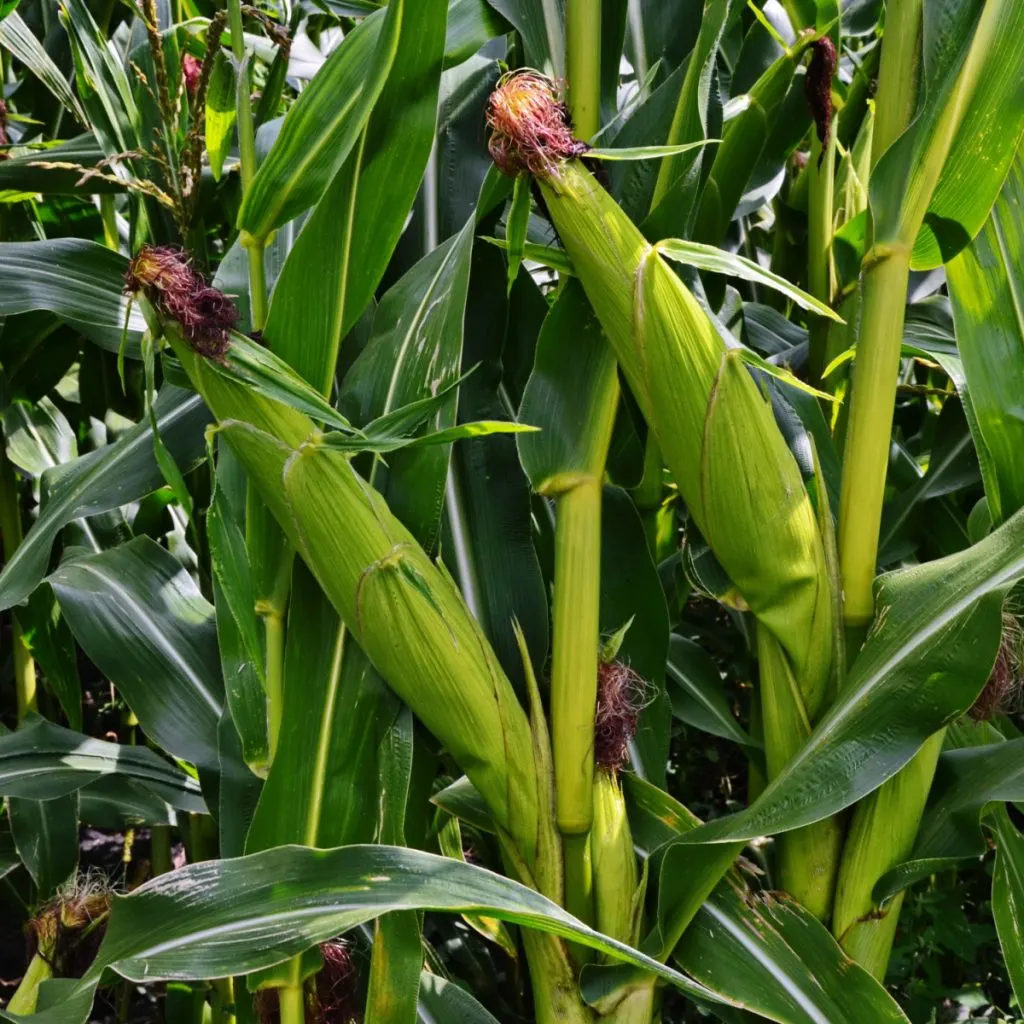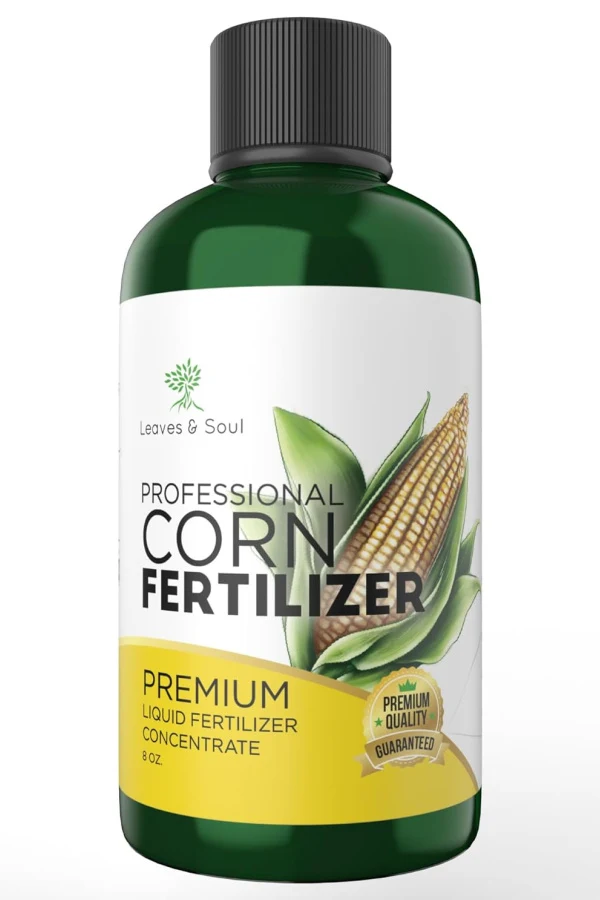Did you know that one of the most important things you can do for your sweet corn crop is to fertilize it. In fact, not only will it help grow healthier, larger stocks and a bigger harvest of corn, but it can also help the ears of your corn to be fuller and tastier as well!
There is simply nothing better than enjoying the incredible taste of fresh sweet corn in the summer. Especially when it’s fresh-picked from your own garden.
But there are a few secrets to growing a successful crop of tasty sweet corn. And one of the biggest secrets of all is making sure your corn has the nutrients it needs to develop and flourish – and that is exactly where fertilizing comes into play!

Sweet corn takes a fair amount of nutrients from the soil as it grows and matures. And without additional supplements throughout a season, it can easily run out of steam. Especially if it happens to be growing in garden soil that had corn or other heavy feeding vegetables planted in it the previous year.
But fertilizing corn is different than fertilizing most vegetable crops. Sweet corn’s nutrient needs actually vary based on where it is in its growth cycle. And to really grow great sweet corn, you need to fertilize it in the right way, and at just the right time.
How To Fertilize Sweet Corn – The Secret To Growing Great Sweet Corn!
Sweet corn benefits immensely from 3 simple and timely fertilizing applications. The first is at planting time. This dose, as you will see below, is different than the final two. It is an extremely light feeding that helps seeds to establish quickly without burning them out.
The second fertilizer application should come as the corn reaches around 4 weeks of age. This dose, as with the final application (at 8 to 10 weeks) needs to be more powerful to allow the plant to produce big stalks and full ears.
With growing great sweet corn in mind, here is an in-depth look at each stage of fertilizing, along with the best choices for providing the right nutrients at the right time.

Fertilizing Seedlings – How To Fertilize Sweet Corn
Corn seedlings require a lighter, more balanced dose of fertilizer. This helps the plant to develop good roots, stems and foliage. All of which are extremely important in setting the stage for ears to form within the husks.
At this early stage, too much power from too strong of a fertilizer will cause more harm than good. Not only can it stunt early growth, but it can even kill it off with too “hot” of a dose of fertilizer.
One of the best choices of all to fertilize young seedlings is to use an all purpose granular fertilizer that has a lower percentage of nitrogen, phosphorous and potassium. Affiliate Link: All Purpose Granular 5-5-5 Fertilizer
This will keep from overpowering young seedlings but still get them off to a fast start. A light sprinkling over the surface of the soil around plants is more than enough to do the trick. As the granules break down, they will leach down nutrients to help young seedlings take off.
Fertilizing At 4+ Weeks – How To Fertilize Sweet Corn
The second and third applications of fertilizer for sweet corn are by far the most important. It is at this stage when the roots of the crop are trying to absorb as much power as possible. And when it comes to developing sweet corn, the most important nutrient for this stage is nitrogen.

Nitrogen can quickly be depleted from the soil by a crop of corn. And resupplying it can be a critical part of the corn growing to full maturity. Unlike many fruiting vegetables and flowers that need more phosphorous and potassium to set blooms and fruit, corn needs nitrogen.
It’s not that phosphorus and potassium don’t matter for corn, but not nearly at the same level as nitrogen. The duo of phosphorous and potassium do help aid in strong root and stalk development – in fact, in this case, more potassium than phosphorous is ideal as well. But make no mistake, it is nitrogen that matters most.
There are a whole host of fertilizers on the market for corn and vegetables. The key for sweet corn is to look for one that has an N-P-K ratio that has a higher nitrogen rating. It’s also good to find one that provides more potassium as well – and at least a trace amount of phosphorous. Product Link: LEAVES AND SOUL Professional Liquid Corn Fertilizer | 5-1-5 Concentrate
The Final 2 Doses Of Fertilizer – When & How To Fertilize Sweet Corn
Once your seedlings have been growing for four weeks, it’s time to apply the fertilizer. By four weeks, the corn crop has become established in the soil and can handle its first stronger supplement of nutrients. You will want to apply the first feeding at 4 weeks – and another at 8 weeks. You can use either a liquid fertilizer or a granular one for this as both work well.
Using Granular Fertilizer
How you apply the fertilizer is important. If you are using a granular fertilizer, the best way to apply it is by using a side dressing technique. Spread the fertilizer into the soil about 3 inches to each side of the main stalk down the row.
This allows the crop to absorb the nutrients down at the root level, and keeps the foliage from being damaged from the fertilizer. Granular fertilizer left on the foliage or at the base can be too hot and burn the plant quite easily.
As for how much to apply, a good rule of thumb is about 1/8 of a cup for every two to three corn plants. Many times, rates of application are given in pounds per square foot, but for a home garden, that can be hard to relate. The cup ratio works well and is much easier to use in practical terms.
Using Liquid Fertilizer – When & How To Fertilize Sweet Corn
If using a liquid fertilizer such as the one recommended above, simply mix according to instructions with water and apply to the soil around your plants. Liquid is a far faster acting fertilizer and can supply the sweet corn with the nutrients it needs faster – but both liquid or granular fertilizers will do the trick.
The biggest key of all is making sure to fertilize! Here is to powering your sweet corn this year and to growing your best crop ever. For more on fertilizing vegetables, check out our article on powering your cucumber plants: Fertilizing Cucumbers – How To Power Your Plants To A Big Harvest!
This Is My Garden
Follow Our Facebook Page For Great Gardening Tips And Advice! This Is My Garden Facebook Page
This Is My Garden is a garden website created by gardeners, for gardeners. Jim and Mary Competti have been writing gardening, DIY and recipe articles and books and speaking for over 15 years from their 46 acre Ohio farm. They publish three articles every week, 52 weeks a year. Sign up today to follow via email, or follow along!

